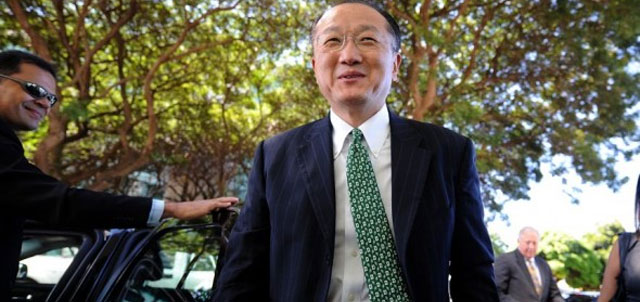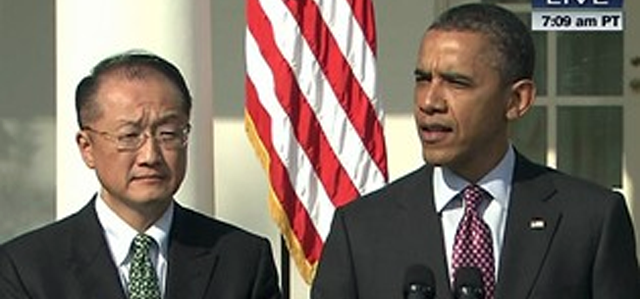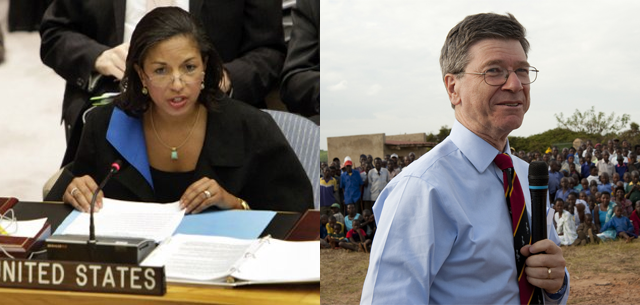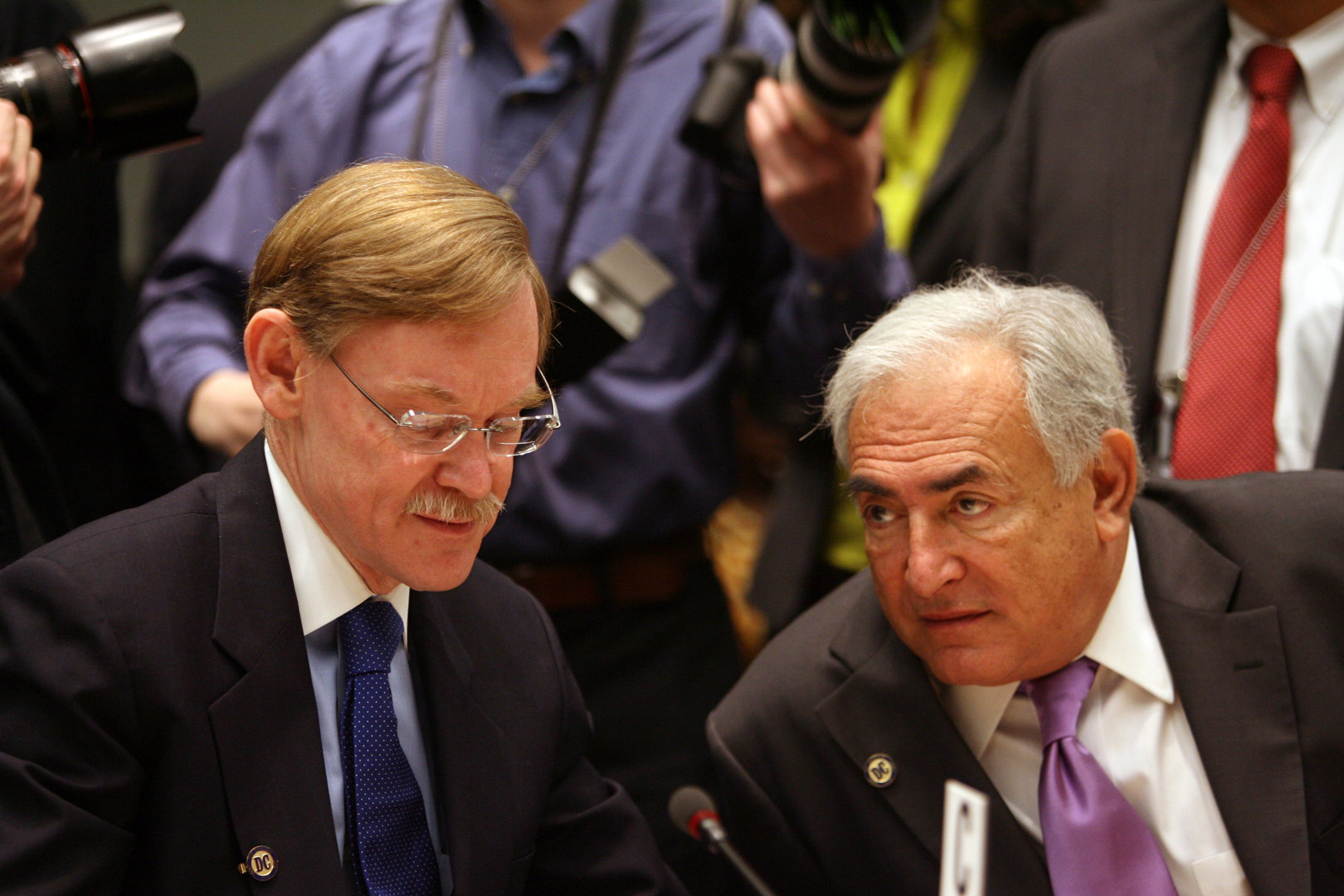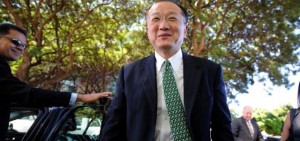
(Photo:Pedro Ladeira/AFP/Getty Images)
This article follows most of the wrap-up and post-election analysis, but hopefully will still add a bit to the conversation over last week’s World Bank presidency selection. A number of meetings, trips and other obligations kept me from pulling it together before now. The race was an historic one, and despite the Board of Directors once again choosing the nominee of the United States, virtually all observers have concluded that this year’s selection was far more open and engaged than ever before.
The candidates — Ngozi Okonjo-Iweala of Nigeria, Jose Antonio Ocampo of Columbia (nominated by Brazil), and Jim Yong Kim from the United States — were each imminently qualified for the post and made the race notably competitive for the first time in the institution’s history. Ironically, it was the U.S. nominee that was least the economist or politician expected among the nominees.
A few key mechanisms, either employed for the first time or used more robustly this year, made the difference. These included a formal deadline for nominations, public dialogue by the candidates and consensus building on a final candidate. Nonethless, other aspects – a fleeting nomination period, limited engagement with stakeholders, and closed interviews – show just how far the Bank has to go to meet emerging standing for global leadership selection.
At the selection’s commencement in February, reform advocates and development groups appealed for a more inclusive selection process, involving both the Bank’s Board of Directors and the more representative Board of Governors. The stated intent behind this was to ensure the eventual officeholder had an understanding of the challenges faced by the Bank’s smaller members and beneficiaries. This was in large part mooted by the United States’ nomination of Dr. Jim Yong Kim, an experienced development and global health expert (rather than, surprisingly, a hardnosed economist or political appointee). Nonetheless, there remained the underlying hope that Bank members would choose someone that, while qualified, was a rejection of the United States’ traditional hold on the post.
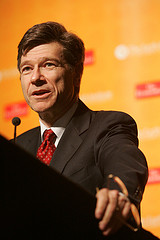
In addition to efforts by civil society groups to recruit qualified non-Americans for nomination, Jeffrey Sachs, an American and highly regarded economist and expert on sustainable development, launched an independent candidacy for the post. Sach’s unusual move garnered praise from civil society groups and a number of progressive U.S. lawmakers. The possibility of his being a mere vanity candidacy disappeared once Sachs starting receiving endorsements from the finance ministers of several smaller World Bank members.
It was only after the nomination of Dr. Kim, whom he considered highly qualified for the post, that Sachs withdrew his name from further consideration. Nonetheless, it almost certainly contributed to a more meritorious nomination and raised the bar for United States. Any other American put forward by the U.S. whose qualifications did not minimally compare to Sach’s would have immediately derailed any rationale European states could have put forward for supporting the U.S. nominee.
In comparison with other multilateral selections, the Bank is making slow progress in adopting more transparent and meritorious selection procedures. Concerns about voting shares and the majority requirement for election of the President remain an obstacle to an ideal process, but the improvements in the process leading up to the vote itself are occurring, and should be continued and strengthened in the future.
Shortly after Robert Zoellick’s announcement that he would not seek a second term, the Board of Directors announced desired criteria for candidates and a deadline for their nomination. As with most multilaterals, the qualifications were more descriptive and operational rather than laying out the anticipated goals for the officeholder to achieve. In essence, the Board sought nominees who were strong, articulate diplomats capable of running a large international organization. Demonstrated experience in sustainable development or economics was not required beyond understanding and promoting those goals as the core mission of the Bank. This left nominations open to more political considerations, and many early rumored American candidates in fact lacked such experience.
Though the criteria for candidates could have been more well-defined, the Board should not criticized too harshly in setting out the deadlines for nomination and consideration of candidates. Zollick announced he would not seek a second term less than five months before the conclusion of his first, forcing a very tight schedule for identifying, vetting and selecting his successor.
Two periods in this timeframe are important to note – the date between the triggering of a candidate search and the close of nominations, and the duration between that date and the vote on the candidates. Zollick made his announcement on 15 February, and the Board announced 23 March as the closing date for nominations, barely a five-week period. In contrast, the World Health Organization, the World Trade Organization, the Food and Agricultural Organization have nomination timeframes (when the incumbent is not seeking re-election) ranging from 6-12 months. For the Bank to move toward this emerging standard, Dr. Kim (whose term will end in June 2017) should be encouraged to announce no later than the Bank’s annual meeting in October 2016 whether he intends to stand for re-election.
Also critical during the nomination timeframe is the length of time, where multiple candidates are present, between the close of nominations and the selection of the officeholder. It is during this period when the shortlisted candidates reach out to stakeholders and promote their candidacies. In the last decade, a lengthy period has been provided to candidates for several multilateral posts to engage in both private consultations with member states and public campaigning with civil society groups. The six candidates for Director-General of the FAO had over 4 months to respond to member states and other stakeholders about their qualifications. Similarly, the WHO member states were provided 2 months to assess the 13 nominees for the organization’s Director-General. In contrast – and again, in large part due to the short turnaround available to the Bank — only 3½ weeks elapsed between the close of nominations and the Board’s selection of Dr. Kim on 16 April. Despite best efforts, this provided insufficient time for the nominees to travel to foreign ministries around the world and for member states to genuinely scrutinize the candidates’ credentials.
Should Dr. Kim make an announcement at the 2016 annual meeting as suggested, the Bank should provide for a appropriate timeframe to allow candidates and governments to engage each other. Closing nominations in early January 2017, for example, would provide a full 3 months for governments to identify the most qualified candidates, and another 3 months for those put forward to promote themselves before a vote at the spring meeting in April 2017. This lengthier, more engaged process would almost certainly lead to greater satisfaction among member states at all development levels as well as civil society, regardless of the outcome.
No matter how long the nomination and consideration phases may be, multilaterals eventually need to narrow the list of nominees. Doing so not only discourages weaker candidates, but also helps build consensus and support for eventual officeholder. There are a number of mechanisms which multilaterals have come to use for this purpose, including developing a shortlist of candidates (which may or may not be publicized), formal interviews, and one or more straw polls. The Bank included the first two of these in its announced process this year, and eventually included a straw poll prior to the final vote. (A formal shortlisting proved unnecessary as the Board intended to invite three candidates for interviews, and only three emerged as formal nominees.)
In this regard, the Bank should be commended for employing these mechanisms which promote effective consensus building. Going forward, it should build on this openness to increase transparency at each stage. With only three formal nominees this year, publicizing the shortlist was not controversial, but doing so should encourage a similar transparency in the future.
Likewise, the Board’s private and off-the-record interviews of the nominees should be complemented (at least) by open and public hearings at which the candidates are invited to make statements. The lack of such this year was where the Bank’s traditional opaqueness was re-asserted, and justifiable criticized by civil society. Responding to the need for some degree of transparency at this stage, the Washington Post and the Center for Global Development hosted a forum for the three nominees to share, individually, their platforms and views on the future of the World Bank. Ngozi Okonjo-Iweala and Jose Antonio Ocampo accepted, and their interviews were publicly webcast for any interested stakeholders and others, while Kim declined the invitation.
Following the interviews, the Board conducted a straw poll to assess the support for each candidate. Straw polls have been increasingly used by other multilaterals in recent years as a mechanism assess how broadly supported a candidate may be and/or to facilitate narrowing the number of candidates to be further considered. As with the Bank’s closed-door interviews, the final results were not shared, but rumors suggested that Kim and Okonjo-Iweala scored highest, and that Ocampo’s withdrawal from consideration was due in part to his low showing in the straw poll (including lack of support from his home country, Colombia). In addition to the support from the U.S. and European member states, Kim was reportedly supported by the BRICS states and other emerging economies. On Monday, 16 April, his selection was formally approved by the Board – though it was not unanimous, and once again, without results being made public.
In the end, Kim’s selection was a much improved outcome of a process that has long been criticized as locking out other candidates and failing to meet minimal standards of transparency and openness. Most improvements in multilateral selections have emerged from prior contentious processes. This proved true in the WTO and WHO selections earlier this decade, among others. Previous Bank selection fights led to the improvements adopted in 2010 and 2011 that contributed immensely to the expectations and satisfaction of this year’s selection. If Bank members come away from this year’s selection more satisfied with the process, they may be more inclined to weigh development experience over mere political acumen in qualifying future nominees.
It may not be the last year that the United States will hold the top post, but it could very well be the last that the “gentlemen’s agreement” between the U.S. and Europe will dictate the outcome. Future selections – not only in the Bank, but in other multilaterals – will incorporate the more satisfactory aspects and mechanisms employed by the Bank, particularly if Kim’s performance in the next few years meets with high approval levels.

